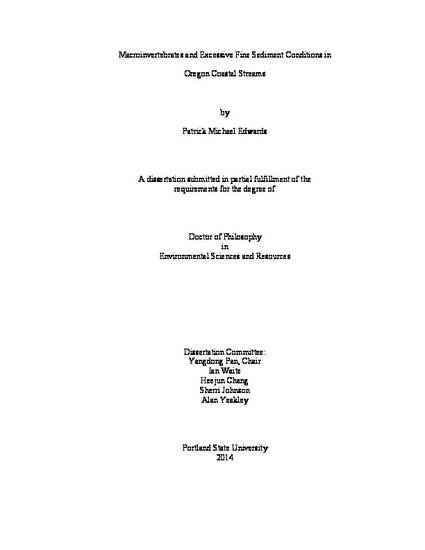
- Indicators (Biology) -- Oregon -- Pacific Coast,
- Stream invertebrates -- Effect of sediments on -- Oregon -- Pacific Coast,
- Salmonidae -- Effect of sediments on -- Oregon -- Pacific Coast,
- Water quality biological assessment -- Oregon -- Pacific Coast,
- Stream ecology -- Oregon -- Pacific Coast
The Pacific Coastal ecoregion contains large tracts of economically important forest lands that also serve as critical stream habitat for endangered Salmonids. Excessive fine sediment deposition in streams of this region is a major environmental concern in the region but difficult to measure directly. The use of stream invertebrates to monitor fine sediment conditions in streams requires careful consideration of several important factors that complicate their use as bioindicators including high spatial and temporal variability and covariance with other environmental variables.
To evaluate the use of stream invertebrates as bioindicators of excessive fine sediment, three hypotheses were tested. The first hypothesis was that invertebrates would be related to broad-scale climate variables (Chapter 2). The second hypothesis was that functional aspects of the invertebrate community would serve as useful indicators of excessive fine sediment condition (Chapter 3). The third hypothesis was that invertebrates in streams with naturally high levels of sediment would be tolerant to fine sediment (<2 >mm, Chapter 4). Hypotheses were tested using a temporal data set at two streams in western Oregon, spatial data from 214 sites across the Oregon Coast Range, and in-situ experiment conducted in streams with erosive or resistant geologies.
In the temporal study, both invertebrate density and functional traits were positively related to El Nino strength (R2 range = 0.22-0.36, ρ range = 0.008-0.04) and air temperature (R2 range = 0.32-0.49, ρ range = 0.002-0.01). The spatial study identified several environmental and hydrological factors that exhibited strong negative controls on both fine sediment (Mantel r range 0.14-0.25, ρ range = 0.001-0.01) and invertebrate Scrapers (R2range = 0.11-0.14, ρ range = 0.001-0.04). The result of the experimental study provide evidence that invertebrates in streams with erosive geologies exhibit tolerance to sediment addition when compared to invertebrates in resistant geologies (mean loss=15%, ρ
The findings of this research demonstrate the role of geology in shaping invertebrate communities and their functional response to fine sediment addition and identify functional indicators that may be useful in different geologic settings. For environmental managers in the Pacific Coastal ecoregion, these findings are of potential value in assisting with the identification of biologically-relevant changes in stream fine sediment conditions and support efforts to balance economic needs in the region while protecting critical Salmonid habitat.
© 2014 Patrick M. Edwards
In Copyright. URI: http://rightsstatements.org/vocab/InC/1.0/ This Item is protected by copyright and/or related rights. You are free to use this Item in any way that is permitted by the copyright and related rights legislation that applies to your use. For other uses you need to obtain permission from the rights-holder(s).
Available at: http://works.bepress.com/patrick_edwards/2/
